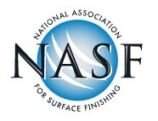Corrosion & Accelerated Corrosion Tests
The course consists of 7 lessons. Each one contains a wealth of valuable, practical information. And if you score 70 or above on the optional exam, you will receive 1 credit toward certification as a Master Surface Finisher. MSF is the world’s most respected — and most widely recognizes– designation for finishing industry professionals. Those passing 6 course exams earn the coveted MSF designation.
Who Benefits?
This training program is beneficial for operators of accelerated corrosion tests and supervisors of metal finishing shops and captive shops that have in-house corrosion testing capability or that outsource testing to outside laboratories. The course is also beneficial to sales personnel serving the metal finishing industry, as it covers valuable information about the corrosion resistance of various coatings.
Goal:
The goal of this course is to provide the student with a general knowledge of common corrosion mechanisms, how they are employed in accelerated corrosion tests, and best operating practices for conducting accelerated corrosion testing.
Course Description:
- Corrosion Principles, Tests & Design for Corrosion Protection Part 1
This lesson begins by identifying the most common mechanisms for the onset of corrosion. The lesson that describes the galvanic/Electromotive Force Series of metals and how they apply to corrosion of plated parts. The concept of galvanic corrosion cells is further developed to include stressed metal corrosion mechanisms. Students are taught how these mechanisms are incorporated into accelerated corrosion test chambers. How various coatings may or may not afford sacrificial corrosion protection is a main focus of this lesson.
- Corrosion Principles, Tests & Design for Corrosion Protection Part 2
In part 2 of this lesson, differential oxygen concentration corrosion, fretting corrosion, and stress corrosion cracking are covered. A secondary focus of the lesson is the design factors that go into a part that successfully resists (or fails) corrosion tests. The lesson also covered ASTM B456 requirements for electroplated copper-nickel chromium deposits. - Equipment for Salt Spray Testing
This lesson provides equipment guidelines for conducting accelerated corrosion testing with a focus on the salt spray test. Each major component from the cabinet to the spray nozzle is described in detail along with the differences in design between various suppliers.
- Salt Spray Cabinet Maintenance & Operation
This lesson provides a detailed look at operational conditions that can affect test results. Special attention is given to monitoring chamber conditions and recordkeeping.
- Preparing, Exposing & Evaluating Parts
This lesson explores the most often mentioned question regarding salt spray testing; “how should parts be masked, exposed, and evaluated?” Numerous examples are provided. Students are also taught how to handle parts before and after testing, and how to recognize surface corrosion.
- Alternate Accelerated Corrosion Tests
This lesson provides basic information on other accelerated corrosion tests, including CASS, Corrodkote, Acetic Acid, and Kesternich tests, with a special focus on the increasingly popular CASS (Copper Accelerated Salt Spray) test. An important part of this lesson is how to conduct a corrosivity test on a CASS test chamber. Equipment and operational differences between the alternate and the sea salt spray test are also given.
- Salt Spray Failures
The salt spray test may indicate a coating failure, even when the coating has been properly applies. This is most commonly found on aluminum test panels that have been conversion coated and on boric sulfuric anodized aluminum test panels processed per aerospace specifications. The lesson explores the potential cause of failures including problems in conducting the test, problems with the test panels, and problems on the processing lines. The lesson focuses heavily on operational conditions that can easily be overlooked– wrong exposure angle, for example.
